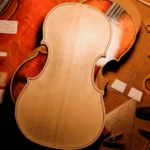Advanced Sound Adjustment: Techniques for Professional Violinists
Back to BlogEvery violin has a unique voice—one that evolves over time and adapts to its player. At Amorim Fine Violins, we collaborate with elite musicians to refine this voice through precise sound adjustments tailored to their performance environment and artistic needs.
What is Advanced Sound Adjustment?
Advanced sound adjustment goes beyond a basic setup. It involves the modification of key components such as:
- Soundpost: The internal piece that transmits vibrations from the strings to the violin’s body.
- Bridge: The part that supports the strings and directly affects projection and tone.
- Strings: Different materials (gut, synthetic, metal-core) influence tone and response.
- Tailpiece: Impacts string tension and tuning stability.
- Fingerboard: Its curvature and finish affect playability and resonance.
These adjustments are performed with precision, considering the player’s style, acoustic demands, and musical preferences.
Key Components in Sound Adjustment
1. Soundpost and Bridge: The Heart of Sound
The soundpost is vital in transmitting vibrations from the strings to the violin’s body. Its positioning and adjustment can drastically affect clarity, brightness, and projection. Similarly, the bridge must be finely shaped to ensure optimal contact with the strings, influencing the violin’s dynamic response and tonal balance.
2. Strings: Selection and Tension
The choice of strings plays a crucial role in determining the violin’s tone. Gut strings offer a warm, complex sound, while synthetic strings provide greater stability and durability. String tension must be carefully adjusted to balance pressure on the violin’s body, affecting resonance and ease of play.
3. Tailpiece and Fingerboard: Stability and Comfort
The tailpiece must be selected based on the material and length that best complement the player’s style. Its adjustment influences tuning stability and string response. The fingerboard must be comfortable and suited to the player’s technique, ensuring ease of execution and a responsive tone.
The Player-Luthier Synergy
The advanced sound adjustment process is a collaborative journey. The musician shares their perceptions of tone, responsiveness, and playability, while the luthier applies their expertise to translate those impressions into precise adjustments. This ongoing dialogue results in an instrument that truly reflects the musician’s artistic identity.
Benefits of Advanced Sound Adjustment
- Enhanced projection: Greater volume and clarity, crucial for performances in larger spaces.
- Balanced tone: Fine-tuning frequencies to ensure an even sound across all strings.
- Dynamic response: Improved control over nuances and articulation, offering a more expressive performance.
Comfort and playability: A violin adapted to the physical needs and stylistic preferences of the player.
Advanced sound adjustment is an art that combines technical skill, sensitivity, and deep knowledge of the instrument. At Amorim Fine Violins, every violin is treated as a unique masterpiece, with personalized adjustments aimed at extracting the best of its sound. If you are a professional violinist seeking an instrument that translates your musical expression with precision, contact us today to schedule a personalized sound assessment.









